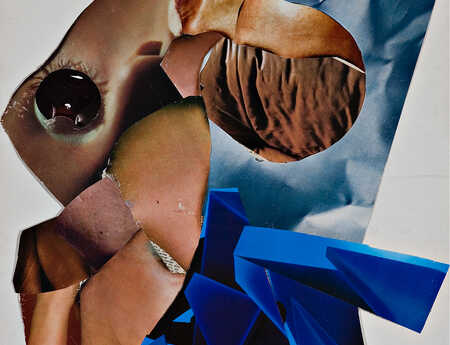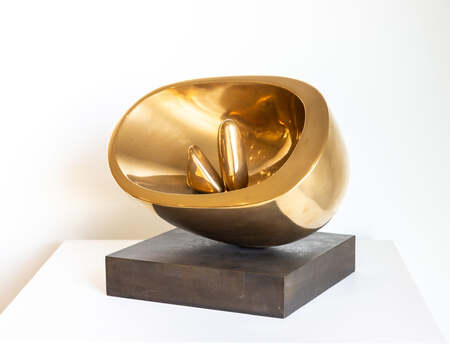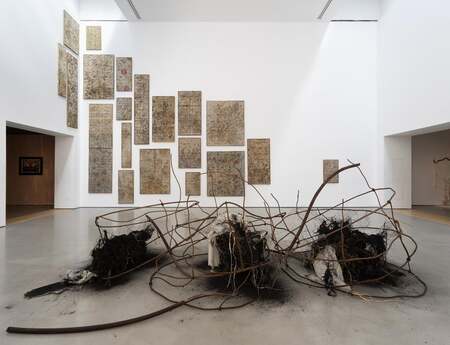PAV Parco Arte Vivente Centro sperimentale d'arte contemporanea
via Giordano Bruno 31
Turin
Italy
WHERE THE LIANAS INTERTWINE. Binta Diaw
curated by Marco Scotini
On Friday, October 31, 2025, the PAV Parco Arte Vivente presents Where the lianas intertwine. Resistances, alliances, lands, a solo exhibition by artist Binta Diaw, curated by Marco Scotini.
Following solo exhibitions by Navjot Altaf, Arahmaiani, and Regina José Galindo, Diaw’s project marks a new and important chapter in PAV’s ongoing investigation into the connections between nature, the female body, and decolonial thought.
The title of the exhibition draws inspiration from the liana, a climbing plant known for its ability to adapt and endure, symbolizing vital alliances and collective resilience. Through environmental installations, organic materials, and historical references, the artist explores themes of Afro-diasporic memory, ecological survival, and female resistance.
Born in Milan in 1995 to Senegalese parents, Binta Diaw carries out a body of work that weaves together ecology, feminism, and colonial history, focusing on the relationship between body, nature, and identity. Her artistic practice draws on symbolic materials such as soil and synthetic hair, used as tools of cultural transmission and poetic resistance.
At the heart of the exhibition are two key works: Dïà s p o r a (2021), an installation presented at the 2022 Berlin Biennale, composed of a suspended web-like structure made from braided hair. The piece evokes the silent resistance of enslaved women who hid seeds and maps in their hair, transforming the body into a living archive and a site of clandestine survival. Chorus of Soil (2019) is an installation that reproduces the layout of the slave ship Brooks, created with soil and seeds. The outlines of the slaves, symbols of oppression, also become vegetal germinations, turning the ship into a garden of memory and rebirth.
The series Paysage Corporel and Nature centers on the artist’s own body, transformed and reinterpreted as a landscape. Naître au monde, c'est concevoir (vivre) enfin le monde comme relation, a work located in the outdoor space, is inspired by eco-feminist readings of the mangroves in Senegal.
Completing the exhibition path is the video work Essere corpo (“Being Body”), which synthesizes the connections between memory, body, and nature, transforming the exhibition space into a place of passage and relationship with the living. The works unfold in an immersive environment made of earthen carpets, suspended installations, and woven textile elements, evoking the sinuous paths of lianas in the forest.
The exhibition takes shape as a choral landscape where aesthetic and political dimensions intertwine, offering new images of community and belonging. With this exhibition, PAV reaffirms its commitment to building a new political ecology, capable of rethinking the relationships between art, nature, and global society.
As part of Binta Diaw’s solo exhibition, on December 10 the AEF/PAV (Education and Training Activities) present Wunderkammer d’Altrove, a training course developed within the aulArte program, a project supported by the Fondazione per l’Arte Moderna e Contemporanea CRT to promote access to cultural spaces for teachers from Piedmontese schools through training activities based on contemporary art practices.
For schools and groups visiting the exhibition Where the lianas intertwine. Resistances, alliances, lands and the installations located throughout the 23,500-square-meter park, the workshop Radici volanti will be offered — a moving, participatory laboratory held either inside the museum or in the open park space. Participants will collectively create, stitch by stitch, a textile chain to connect with one another through a playful and communal action.
BIO
Binta Diaw (Milan, 1995) is an Italian-Senegalese visual artist working internationally. Raised between Italy and Senegal, she studied at the Brera Academy of Fine Arts in Milan and at the École d’Art et de Design in Grenoble, France.
Her practice spans installations, sculpture, video, photography, and performance, and is deeply rooted in a philosophical reflection on contemporary social phenomena such as migration, diasporic identity, belonging, and gender issues. In her works, natural and symbolic materials—earth, chalk, rope, synthetic hair, and rolled-up flags—form a sculptural language centered on the physical and sensory experience of the viewer, inviting them to confront their own position in the world and in relation to the artwork.
Diaw’s work is nourished by Afro-diasporic, intersectional, and feminist perspectives and serves as a critical response to the dominant Eurocentric narrative. Through her art, she explores the many layers of identity—both her own, as a Black woman in a Europeanized context, and the collective identity of a continent marked by histories and geographies in dialogue and in conflict. Her work gives voice to marginalized memories and promotes a more conscious, inclusive, and plural understanding of the present.
Her works are part of prestigious private collections and have been presented in numerous solo and group exhibitions, as well as at major institutions including: MAXXI – National Museum of 21st Century Arts (Rome, IT); Fondazione Sandretto Re Rebaudengo (Turin, IT); Museo Madre (Naples, IT); Liverpool Biennial (UK); Berlin Biennale (GER); Swiss Institute (Rome, IT); Italian Cultural Institute of Dakar (SN); Express Newark (US); Fondazione Nicola Trussardi (Milan, IT); Gwangju Biennale (KR); Magasin CNAC (Grenoble, FR); Museo Novecento (Florence, IT); Palazzo Grimani (Venice, IT); Institut Culturel Italien de Paris (FR); FRAC Alsace (Sélestat, FR); Castello di Rivoli (IT); Bamako Encounters (Mali, MLI); Murate Art District (Florence, IT); Centrale Fies (Dro, IT); MUSEION (Bolzano, IT); Galerie Cécile Fakhoury (Paris, Dakar, Abidjan); Prometeo Gallery (Milan, IT).


